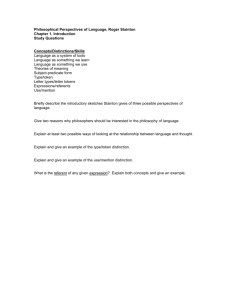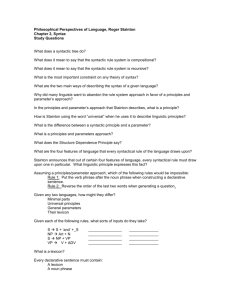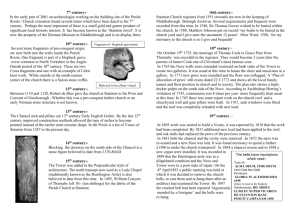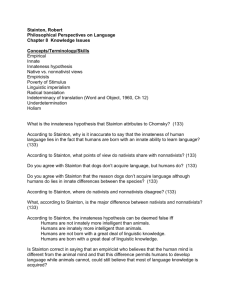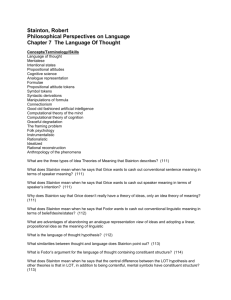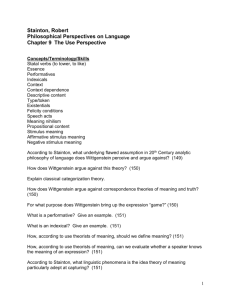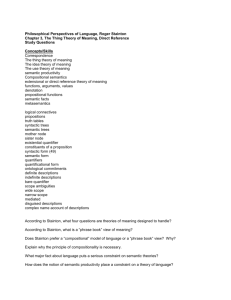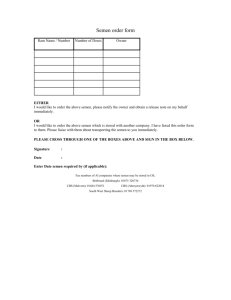Reply to Stainton PPR
advertisement
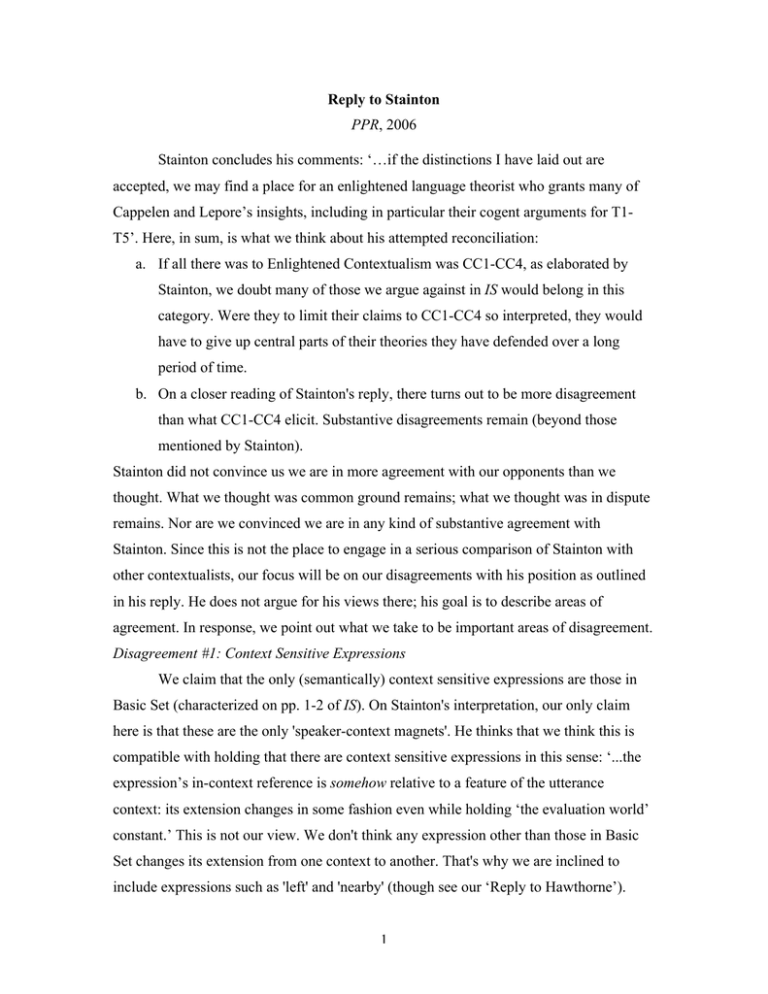
Reply to Stainton PPR, 2006 Stainton concludes his comments: ‘…if the distinctions I have laid out are accepted, we may find a place for an enlightened language theorist who grants many of Cappelen and Lepore’s insights, including in particular their cogent arguments for T1T5’. Here, in sum, is what we think about his attempted reconciliation: a. If all there was to Enlightened Contextualism was CC1-CC4, as elaborated by Stainton, we doubt many of those we argue against in IS would belong in this category. Were they to limit their claims to CC1-CC4 so interpreted, they would have to give up central parts of their theories they have defended over a long period of time. b. On a closer reading of Stainton's reply, there turns out to be more disagreement than what CC1-CC4 elicit. Substantive disagreements remain (beyond those mentioned by Stainton). Stainton did not convince us we are in more agreement with our opponents than we thought. What we thought was common ground remains; what we thought was in dispute remains. Nor are we convinced we are in any kind of substantive agreement with Stainton. Since this is not the place to engage in a serious comparison of Stainton with other contextualists, our focus will be on our disagreements with his position as outlined in his reply. He does not argue for his views there; his goal is to describe areas of agreement. In response, we point out what we take to be important areas of disagreement. Disagreement #1: Context Sensitive Expressions We claim that the only (semantically) context sensitive expressions are those in Basic Set (characterized on pp. 1-2 of IS). On Stainton's interpretation, our only claim here is that these are the only 'speaker-context magnets'. He thinks that we think this is compatible with holding that there are context sensitive expressions in this sense: ‘...the expression’s in-context reference is somehow relative to a feature of the utterance context: its extension changes in some fashion even while holding ‘the evaluation world’ constant.’ This is not our view. We don't think any expression other than those in Basic Set changes its extension from one context to another. That's why we are inclined to include expressions such as 'left' and 'nearby' (though see our ‘Reply to Hawthorne’). 1 Stainton notices that we disagree on this point. He says: ‘I would argue given space that T1 is false on sense (1b): there are context sensitive expressions that aren’t speakercontext magnets.’ We wish we had given us that argument, because we include that claim in our understanding of what Stainton thinks of as our T1. That is, T1, as we construe it, is incompatible with denying 'on sense (1b).' Disagreement #2: Truth-Conditionality Stainton attributes T2 to us: ‘Once referents are assigned to these basic and obvious items in a (declarative) sentence, that sentence has truth conditions.’ He thinks the 'enlightened contextualist' can accept T1 if 'truth condition' is interpreted as 'Tarskian truth-conditions'. We're a bit at a loss here since we have no idea what 'Tarskian truth conditions' are, if they are distinct from truth conditions. If what he means is that we endorse the view that ‘‘Nina has had enough pasta’ is true iff Nina has had enough pasta’ is true, then this is correct. This, of course, is what Radical Contextualists like Travis (1985, 1989, 1996) and Bezuidenhout (2002, 2006) deny. What we mean by sentences having truth conditions is nothing as theoretical as what Tarski had in mind. We don't mean to be committed to any particular truth theory or any particular theoretical framework for deriving truth conditions. We simply mean that these specify conditions the satisfaction of which is both necessary and sufficient for the truth of the sentence. Our theoretical neutrality is expressed by our dual appeal to truth conditions and propositions. When we say in IS that a sentence S has truth conditions we also say it expresses a proposition. The neutral formulation we use is: ‘S expresses the proposition that p, and is true iff p’. This appeal to proposition cannot, we take it, be captured by Stainton's interpretation of T1, but it is an important component of our position. We do not mean our theory to require a certain semantic framework for thinking about truth conditions. We do have our theoretical sympathies, but nothing in IS should depend on these. Disagreement #3: 'Relativized Truth Conditions’ Stainton's CC2 says that sentences typically do not have truth conditions, even once relativized. He explains 'relativized truth conditions' as follows: …a disambiguated expression type has truth conditions only if it is true or false – it partitions the worlds – relative to a set of previously established parameters. Example parameters include speaker and addressee (for ‘I’ and ‘you’), objects, 2 times and places demonstrated (for ‘this’, ‘that’, ‘then’ and ‘there’), utterance time (for ‘now’, ‘today’, ‘yesterday’, and tense), place of utterance (for ‘here’), and world of utterance (for ‘actual’). If we understand what Stainton has in mind with his use of 'parameter', this is another point of disagreement. As we argue in IS, once these parameters are fixed, we get a full fledged proposition, something capable of being true or false. Again, Stainton doesn't tell us why sentences lack truth-conditions in this sense (his sense (2b)) - that's not the goal of his comment. His goal is to lay out areas of agreement and disagreement transparently. Given that this is his goal, all we will do here is indicate that we didn’t intend our claim to be simply his (2a) if that's understood as compatible with denying (2b). Disagreement #4: Missing Linguistic Ingredients We're not sure why Stainton thinks the issue of unarticulated constituents or 'missing linguistic ingredients' belongs in a discussion of the different senses of 'truth condition'. This, it seems to us, has to do with the object evaluated, not with the nature of the evaluation. That issue aside, this is a fundamental disagreement between the position in IS and Stainton's enlightened contextualist, one worthy of more than the parenthetical remark Stainton affords it. This issue is at the core of our objection to Moderate Contextualism in Chapters 3-6 and of Radical Contextualism in Chapters 7-9. Again, if this disagreement remains between the enlightened contextualist and us, we don't see that much has been gained. This also has implications for how to understand Stainton's claim that his enlightened contextualist can agree with T1 interpreted as (1e). We are not really in agreement about T1 so interpreted because Stainton presumably thinks that what has truth conditions in this sense is the sentence with the additional linguistic parameters. He, presumably, thinks the surface structure of 'Nina has had enough' has missing linguistic ingredients. We don't. So when he says he agrees with us that ‘Nina has had enough’ has 'Tarskian truth conditions', he presumably thinks it is this sentence suitably enriched that has truth conditions. But that's not our view. We think it has truth conditions without any addition. Again, this is substantive disagreement. In saying this, we are assuming that Stainton does not hold the view that 'Nina has had enough' without the 'missing linguistic ingredients' has Tarskian truth conditions. We don't see how that view is tenable (if the 3 linguistic ingredients really are missing, they would have to be added for the sentence to have truth conditions; otherwise, we don't know what's meant by saying they are 'missing'). Disagreement #5: Asserted Semantic Content Stainton attributes T3 to us: ‘T3: This truth-conditional content is asserted when the sentence is used’. If this means that we think the semantic content is asserted, that's a correct description of our view (though, this is something we have gone back and forth on – in our 1997 we denied it; other speech act pluralists). On Stainton's view, this is true only on the 'report-oriented' sense of assertion, and not on the intention-oriented sense of assertion. We doubt, however, that there's a clear distinction between these two senses of 'assertion'. Some reports have as their aim to capture speaker intentions, and on our view, our intuitions about what Stainton calls the 'intention-oriented' sense of 'assertion' are derived from such reports. As we see it, the distinction Stainton is getting at is one within the report-oriented sense. It's a sub-set of these – the reports you get in contexts where you care especially about speaker intentions. But that is not our main disagreement with Stainton over assertion. Our main disagreement is about whether the semantic content, as we understand it, is something the speaker intends to assert. On our view, it is. On Stainton's, it is not. Our argument for this is simple: speakers intend to say what their words mean. As a result, they intend to assert the semantic content of the sentence they utter.1 Disagreement #6: 'on-line processing' and minimal propositions Finally, in CC5 Stainton says: ‘The so-called ‘minimal proposition’ is not psychologically relevant.’ This, he says, ‘is true on sense (4b): where there is a minimal proposition, it doesn’t generally play a part in occurrent on-line processing.’ Stainton thinks this is a position we would be willing to endorse. It is not. The entirety of Chapter 12 of IS is devoted to a discussion of what we call the 'psychological argument' against minimal propositions. We discuss Carston and Recanati's argument to the effect that minimal propositions lack psychological reality. In reply, we note that they do have a role: they serve as a guard against the ubiquitous mismatch of contextual information. 1 The complications here have to do with irony and other such speech acts, but we leave those aside for the moment, since they are not at the centre of our debate with Stainton. 4 Speakers and audiences typically perceive the context of utterance in importantly radically different ways, and the minimal propositions serve as a guard against that lack of shared context. Stainton's interpretation of this is that we only claiming that the minimal proposition is ‘at the agent’s cognitive disposal: it can be accessed; it can be made consciously available; it could be used in processing.’ To hold that they have this property is compatible with denying they are ‘psychologically relevant in interpretive situation’, i.e. that the ‘agent occurrently makes use of’ them in the context of utterance. We are not sure how Stainton knows what information plays this second role and why he is convinced that minimal propositions don't. Since we don't know enough about language processing or what's meant by ‘occurrently makes use of' we will suspend judgment. Suffice it to say, our suspicion is that were this notion made precise, it would either include our minimal propositions or exclude them together with whatever Stainton thinks plays this role. But at this point, that's speculation on our part. In conclusion, we don't see a great deal of hope for resolving any of these issues simply through further elaborations of the terms used in framing the debate. This is no doubt an important exercise, but the issues are simple to understand. What's needed is not a deeper understanding of the terms used in phrasing the problems, but, rather, a better understanding of the evidence and improved theoretical frameworks for interpreting this evidence. 5 Bibliography Bach, K., 'Conversational impliciture', Mind & Language 9, 1994, pp.124-162. Cappelen. H. and E, Lepore, ‘Varieties of Quotation’. Mind 106, 1997b, pp. 429-50. Cappelen, H. and E. Lepore, Insenstive Semantics, Basil Blackwell, 2005. Cappelen, H. and E. Lepore, ‘Reply to Critics’, Mind and Language, 2006, forthcoming. Cappelen, H. and E. Lepore, Shared Content and Semantic Spin, in progress. Carston, R., Thoughts and Utterances: The Pragmatics of Explicit Communication, Oxford: Blackwell, 2002. Davidson, D., ‘Quotation’, in Inquiries Into Truth and Interpretation, Oxford, Oxford University Press, 1979, pp.79-92. Originally published in Theory and Decision, 1979 11, pp. 27-40. Egan, A., J Hawthorne and B. Weatherson, ‘Epistemic Modals in Context’, in G. Preyer and G. Peter (eds) Contextualism in Philosophy, Oxford University Press: Oxford, 2005, pp. 131-170. Hawthorne, John, Knowledge and Lotteries, Oxford University Press, 2004. Kaplan, David, ‘Demonstratives’, in Themes from Kaplan, eds. Almog, J. J. Perry and H. Wettstein, Oxford University Press, 1989. Lasersohn, P. ‘Context Dependence, Disagreement, and Predicates of Personal Taste’, Linguistics and Philosophy, 2006, forthcoming. MacFarlane, J. ‘How to Be a Relativist About Truth’ (ms) 2004. Perry, John, Reference and Reflexivity. Stanford: CSLI Publications, 2001. Recanati, F., Literal Meaning, Cambridge: Cambridge University Press, 2004. Recanati, F., ‘Crazy Minimalism’, Mind and Language, 2006, forthcoming. Richard, Mark, ‘Contextualism and Relativism’, Philosophical Studies 119: 2004, pp. 215–242. Stanley, Jason and J. King, ‘Semantics, Pragmatics, and the Role of Semantic Content’, Semantics vs. Pragmatics, Z. Szabo, ed., Oxford University Press: Oxford 2005, pp.111-164. Williamson, T. Vagueness, London: Routledge, 1994. 6 7
